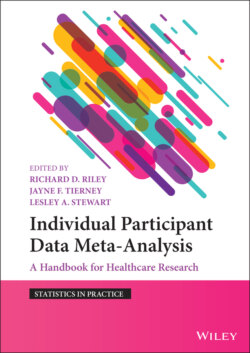Читать книгу Individual Participant Data Meta-Analysis - Группа авторов - Страница 91
4.5.4 Checking the Validity, Range and Consistency of Variables
ОглавлениеIPD should be checked for invalid, outlying or implausible values,7,9,43 as these are the sorts of errors that can occasionally be missed during data input or checking of the original trials, or occasionally could arise as a result of variable recoding by the IPD meta‐analysis project team. Such checks might highlight, for example, records of unusually old or young patients, or those with abnormally high or low levels of important biomarkers, which need to be queried with trial teams. Of course, such apparently implausible values may turn out to be accurate. For example, in a trial included in an IPD meta‐analysis of neoadjuvant chemotherapy for cervical cancer,104 some invalid codes were used for the brachytherapy (internal radiotherapy) variable (Figure 4.6), which were then queried and clarified as representing not applicable. When variables are related, checks should be carried out to ensure that they are coherent and consistent. For example, in a randomised trial, the recorded date of any event should follow the recorded date of randomisation and occur on or before the recorded date of last follow‐up.
At this stage, it is also useful to perform a simple descriptive analysis of the IPD from each trial to provide, for example, the number of participants, distribution of baseline characteristics by treatment group and overall results for the main outcome(s). These can then be checked for concordance with relevant publications or, for unpublished trials, with any results that have been deposited in trial registers (e.g. ClinicalTrials.gov). However, it should be borne in mind that inconsistencies can arise if, for example, follow‐up in a trial’s IPD has been extended beyond that used to derive the reported results, or if the meta‐analysis employs a different approach compared to the original trial analyses. When unexplained differences do arise, it is crucial to work with the original trial investigators to understand how and why they differ, and therefore, be in a position to report and explain any important discrepancies.
Figure 4.6 Summary of the data validity, range and consistency checks on IPD from a trial included in an IPD meta‐analysis of neoadjuvant chemotherapy for cervical cancer104 (N.B. The participant references are pseudonymised).
Source: Based on Neoadjuvant Chemotherapy for Locally Advanced Cervical Cancer Meta-analysis C. Neoadjuvant chemotherapy for locally advanced cervical cancer: a systematic review and meta-analysis of individual patient data from 21 randomised trials. European journal of cancer 2003;39(17):2470–86.
